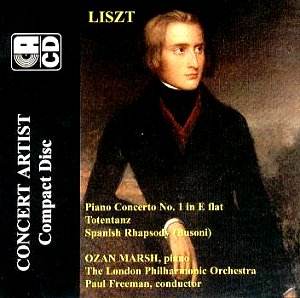Ozan Marsh studied, amongst others, with Emil von Sauer
whose recording of the Liszt Concerto with Weingartner (both were Liszt
pupils) is so prized a memento of his august discography. In 1985 Marsh
went into the studios to record an early version of the E flat Concerto
with the LPO and Paul Freeman. Marsh’s variants are from the 1854 manuscript
and centre on the addition of sixteen bars after the trill at the end
of the second movement fitting as a section before the triangle that
leads onto the third.
Marsh takes an elegant and patrician view of the Concerto.
His voicings in the allegro maestoso are frequently of exceptional
delicacy, his trills graded with precision, his playing informed by
an almost chamber intimacy (listen to his playing beneath the brief
clarinet solo at 2.30 where his dynamics are of real sensitivity). These
exchanges (clarinet, violin) are part of a patina of exchange and flourish
that informs Marsh’s playing. The thematic flux of the opening’s material
is reflected by his exactingly romantic response to it. The sense of
time’s vista opening in the Quasi adagio is palpable and indeed
part of Marsh’s own conception of the work as a whole which, not unlike
but even more than Sauer’s own recording, unfolds in an unhurried way.
The 1854 edition, by the way, has a delightfully well played clarinet
solo, the piano musingly supportive beneath it, then expounding on the
theme, solo, in a kind of quasi-cadenza section of intimate projection
and nicely contrastive with and anticipatory of the more voluptuous
skittishness of the ensuing Allegretto vivace section announced
by the triangle. Even here however Marsh maintains a triumphant finesse
– though he’s not short on technique, as one can hear, but prefers to
keep it in reserve and not paraded. Orchestra and soloist are commanding
in the animato section and in chordal flourish his tone remains even
and round. Marsh’s refined but highly plastic phrasing allow the music
time wittily to breathe in the Allegro marziale section and when
it comes to the Presto there’s no little drama and flourish and
leonine power.
No less enjoyable is the Busoni arrangement for piano
and orchestra of the Spanish Rhapsody. Concert Artist’s notes
remind us – I certainly didn’t know – that it was Bartók who
gave the first performance of it in 1904 (it was also recorded by Petri,
another of Marsh’s teachers, with Mitropoulos). There is once more much
distinguished playing here and none to the gallery. The brass is burnished
in the opening section, the strings exultant and almost smeary in their
romantic leaps. The La Folia quotation is full of sinuously dark
and unnerving undercurrents in Marsh’s hands – hints of things unknown
and unknowable maybe – and elsewhere he is a romantic tonalist of distinction,
left hand never submerged. Even at his most relaxed he is capable of
spinning a resonant and compelling line and these elasticities of phrasing
find their analogue in his rhythmically precise and drivingly exciting
peroration at the work’s conclusion.
The Totentanz performance requires a little
explanation. This is Marsh’s performing version, which has involved
expansion of the sound of the tuttis and has used Liszt’s notebooks
as a source for adding extra material to the existing cadenzas. The
coda would in the old days be written up as Busoni-Marsh as it is essentially
Busoni’s with Marsh adding some amendments. It’s certainly a staggering
tour de force, Marsh doing some breathtakingly saturnine things, roulades
of right hand runs thrown up the keyboard, the bass throbbing to his
power. Yet insistence is but one part of the work’s austere and fearsome
drama – the Dies Irae that courses through it inspires Marsh
to introspective, almost Bachian moments of reflection and timelessness.
I believe that this has been out on CD before – on
a 1988 Vox Turnabout PVT 7191. Concert Artist made a number of recordings
with Marsh and they have added this to their catalogue. I’m delighted
that they have done so.
Jonathan Woolf
Note from Concert Artists
One small point in the interest of accuracy. This CD has never been
available in this country on the Turnabout Label (not even imports were
allowed under the licence) but was released on Concert Artist Cassette
FED4-TC-049 and is still available in our catalogue. It was released
in the USA on CD by Turnabout as stated by Jonathan Woolf. Concert Artist/Fidelio
MusicWeb
can offer the complete Concert
Artist catalogue

![]() Ozan Marsh (piano)
Ozan Marsh (piano) ![]() CONCERT ARTIST CACD
9049-2 [52.53]
CONCERT ARTIST CACD
9049-2 [52.53]